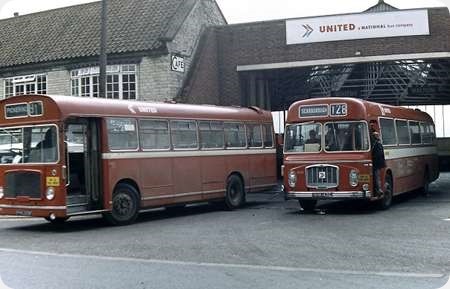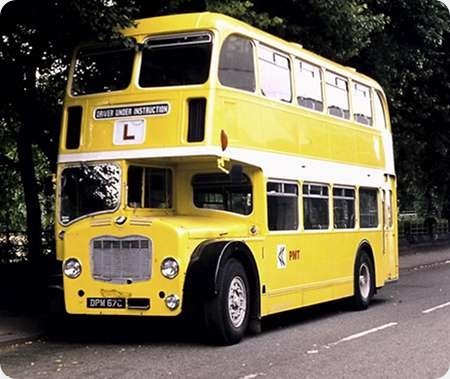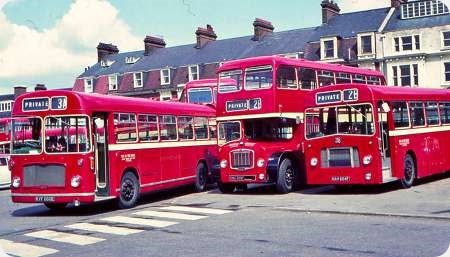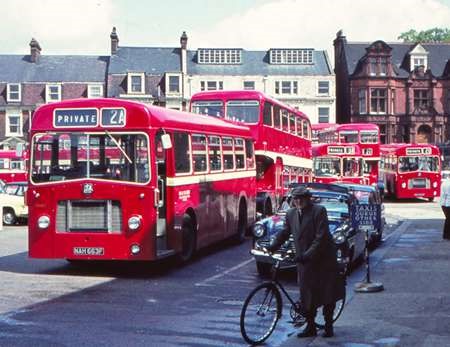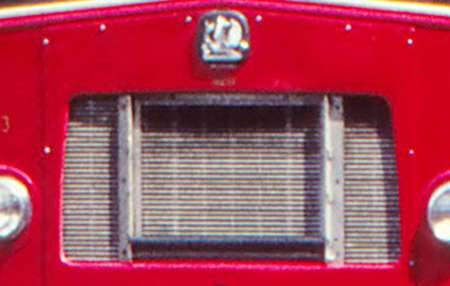United Automobile – Bristol RELH6G – NHN 143E – 4343
United Automobile Services
1967
Bristol RELH6G
ECW C43F
United had a small Garage at Pickering where the forecourt doubled up as a Bus Station.
Here 4343 (originally RE43) is loading for a trip along the A170 seventeen miles to Scarborough.
I expect this vehicle retained its manual gearbox which I would think could be tricky on a Stage Service. It is a good looking bus/coach – shame about the livery!
Photograph and Copy contributed by Ian Wild
12/05/20 – 06:48
Are you sure it had the manual gearbox? Crosville’s E registered RELH6Gs had semi automatic boxes. Even in bus livery, these coaches looked beautiful!
Don McKeown
13/05/20 – 07:03
Probably was semi automatic. West Yorkshire’s E registered RELH were as well. As regards manual boxes I remember some West Yorkshire drivers struggling with earlier B, C, and D registered RELL buses.
Stephen Clough
14/05/20 – 06:52
According to United Automobile Services Part Two by messrs. Townsin, Groves and Banks (Venture Publications), this batch RE41-65 were the first coaches to be delivered with semi-automatic gearboxes.
John Gibson
16/05/20 – 06:33
It might be 17 miles from Pickering to Scarborough, but three times a day (twice on Sundays) the route began in Ripon, via Thirsk, Ampleforth and Helmsley to Pickering and Scarborough, distance of some 60+ miles, some of it on minor roads. In 1976 this took around three and a half hour end to end. The route number groups with other Ripon services, but how it was crewed is a mystery to me. I guess Ripon crews were relieved for a break at Pickering, as two of the through journeys had only five minutes turn round at Scarborough. I would be very interested to know more about the operation of the 128.
Andy Buckland
17/05/20 – 06:37
Andy’s comment reminded me that in the James Herriot book "Vets might fly" James bunked off from his RAF training in Scarborough one Sunday afternoon and travelled by bus to "Darrowby" (which we now know to be Thirsk) to see his pregnant wife, Helen. He had less than an hour before he had to catch the return bus – and as I recall it, his absence without leave was never detected! I assume that this escapade, like many others, was founded in real life.
Stephen Ford
18/05/20 – 06:34
Stephen, by 1976, the date of my timetable, this would not be possible on a Sunday, with just two through journeys each way. You had to leave Scarborough at 10:45 to reach Thirsk by 13:35, returning at 18:10. Now, if in earlier years there had been a third return, as during the week, then 12:45 from Scarborough, arrive Thirsk 15:40, return at 18:27 was possible. Add a bit of poetic licence and we perhaps have the basis for the story.
Andy Buckland
20/05/20 – 07:18
I have been looking at the summer timetable for 1957, and it shows that from 7th July to 14th September, there were three journeys each way between Scarborough and Ripon on Sundays. If he left Scarborough at 10.45, he would reach Thirsk at 1.40 p.m. He could then leave Thirsk at 3.50 p.m. arriving back at Scarborough at 6.40 p.m. So yes, this journey would have been feasible as long as it was made at the height of the summer.
John Gibson
20/05/20 – 07:19
I travelled on service 128 from Helmsley to Ripon in 1976 (MWs all the way from Middlesbrough to Harrogate!!). If memory isn’t playing tricks, we had to change buses at Sproxton, west of Helmsley, and the respective buses then returned home. I can’t remember if the change was advertised in the timetable. A trip form Ross-on-Wye to Abergavenny by Red and White in 1970 (MWs again) certainly involved a change at Broad Oak even though the timetable showed the buses working through.
Phil Drake
21/05/20 – 06:56
And there we have the answer, Phil!
Certainly there is no reference to a change of vehicle at Sproxton, indeed it does not even merit entry in the timetable, but if you look at the times for Helmsley and Ampleforth, then buses would cross roughly where Sproxton is. What makes it strange is that Sproxton is only a few minutes west of Helmsley, where some journeys stood time and interchange facilities are much better. Was there perhaps some unwritten rule that Helmsley to Scarborough was dedicated to Pickering/Scarborough drivers and Ripon was “another company”
Andy Buckland
21/05/20 – 06:56
Definitely semi-auto, we had 4344 at Darlington for a while, not the fastest, comfortable for both driver and passengers it did what it was supposed to do. I used to call it the old mans bus.
John Wake
31/08/20 – 06:27
Regarding the operation of the Ripon to Scarborough service, I lived in Ripon in the late 1960s, and at that time the buses definitely worked through on the whole route, but the drivers did not. When opposing vehicles met, usually in the middle of nowhere, they stopped and the drivers changed over, returning whence they had come from. I presume that with three services each way on weekdays, a Scarborough based vehicle would spend alternate nights at Ripon garage, and vice versa. Obvious the drivers would get back home at the end of their shifts.
Chris Appleby
03/09/20 – 06:18
Where the garage was may be seen here: https://www.google.co.uk/maps/
It would appear that the property was modified to become the carpet showroom it is in the photograph.
I have a snapshot photograph I took on Sunday 23 July 1972 which has four single deckers parked within. //www.ipernity.com/
David Slater
Quick links to the - Comments Page - Contact Page - Home Page
